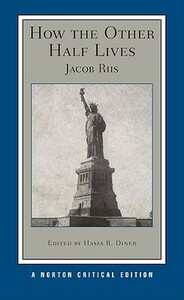Take a photo of a barcode or cover
adventurous
challenging
dark
emotional
sad
tense
medium-paced
Just like Nellie Bly’s book Ten Days in a Mad-House was supposed to show the horrible conditions in Blackwell’s Asylum, this book takes a step off that island and back to New York City, where the poor lived in horrifying conditions. Even reading it in the modern day, it hard to imagine how horrible those people’s lives must have been. Often they would work inside tiny, dark, hot rooms for seventeen hours a day. The landlords wouldn’t fix anything, toilets were outside (five toilets may be shared between a hundred or more people), and dirt and grime was everywhere.
Full review on my blog: https://madamewriterblog.com/2020/02/12/book-review-how-the-other-half-lives-by-jacob-a-riis/
Full review on my blog: https://madamewriterblog.com/2020/02/12/book-review-how-the-other-half-lives-by-jacob-a-riis/
This is an amazing book. I love it because it shows that even though things seem hopeless and beyond repair, people have the power to change things. I love reading how terrible things were knowing that people pulled together and fixed it. I hope they can do the same for the problems we're facing now!
Really loved this edition, Leviatin provides thoughtful insights.
“Those who fight for the poor must fight the poor to do it”, Jacob Riis says in the final chapter of the How the Other Half Lives. This quote is intended to convey his assumption that poor people were undesirous of the changes needed to liberate them from their dark, dirty, and sick tenement lifestyles. The quote is also an apt representation for the way in which Riis dehumanizes people living in the tenements and condescendingly makes arguments ostensibly for their own good. Whether Riis was able to alleviate the issues facing the poor or reinforcing the ideas that birthed their situation is arguable. Undeniably, Riis’ writing embodied the racism, racial naturalism, and individualism that were trending locally and globally. It is a snapshot of time. He is a journalist; documenting his observations and data. But he is, even more so, a storyteller, crafting a compelling narrative about the life in the tenements with a progressive recognition about the systematic problems facing poor people in New York. His compassion directly contradicts his own axioms of the nature of the poor and oppressed. This seemed to have a significant impact on the future of cities, although he does not solely deserve the credit for creating this impact. How the Other Half Lives does remain a tale about the social and physical structure fail to serve and benefit all people. These points are still quite relevant today even if these failures have shifted locations or assumed a new façade.
“Those who fight for the poor must fight the poor to do it”, Jacob Riis says in the final chapter of the How the Other Half Lives. This quote is intended to convey his assumption that poor people were undesirous of the changes needed to liberate them from their dark, dirty, and sick tenement lifestyles. The quote is also an apt representation for the way in which Riis dehumanizes people living in the tenements and condescendingly makes arguments ostensibly for their own good. Whether Riis was able to alleviate the issues facing the poor or reinforcing the ideas that birthed their situation is arguable. Undeniably, Riis’ writing embodied the racism, racial naturalism, and individualism that were trending locally and globally. It is a snapshot of time. He is a journalist; documenting his observations and data. But he is, even more so, a storyteller, crafting a compelling narrative about the life in the tenements with a progressive recognition about the systematic problems facing poor people in New York. His compassion directly contradicts his own axioms of the nature of the poor and oppressed. This seemed to have a significant impact on the future of cities, although he does not solely deserve the credit for creating this impact. How the Other Half Lives does remain a tale about the social and physical structure fail to serve and benefit all people. These points are still quite relevant today even if these failures have shifted locations or assumed a new façade.
Finally a book that’s racist towards my ethnicity. And all ethnicities. This book manages to be bigoted towards every single community in New York City while also calling for progressive policies and honestly that’s kind of impressive
This is not the version I read. Okay, I gave up after reading about four chapters in. But my version of the book was by LibriVox, which gave me the idea to look for free audio. I got through the book, and it wouldn't have happened any other way. It was tough reading. I don't know if it was the small text or dense pages or the content. Probably all of the above. I fared much better upon switching to the audio (although it was weird with the different narrators - and varying quality of the recordings). Still, I think I didn't really grasp all of what Riis was conveying. And, really, a lot of the issues with tenements in New York back then are still with us today in the inner cities of America.
If you're interested in sociology and understanding the history of poverty, please read this book.
Of course it should be read in its historical context. There are a lot of racist and antisemitic views perpetuated that are absolutely unacceptable. Yet for 1890, this was an extremely sympathetic view of those living in poverty in Manhattan. It goes into explicit detail the kind of hardships that many people were facing at the time and even attempts to offer real solutions to help, based in the belief that the impoverished people themselves were not the problem, but structural issues such as lack of employment and incompetent and exploitative landlords, etc.etc. as the real reason they were living in such horrible conditions.
Really though, this book is important because it gives a perspective on the historical aspect of poverty and that poverty has been a long generational issue. The idea of the United States as a meritocracy is a lie as shown through the intimate details of the extremely hard working people in this book.
Of course it should be read in its historical context. There are a lot of racist and antisemitic views perpetuated that are absolutely unacceptable. Yet for 1890, this was an extremely sympathetic view of those living in poverty in Manhattan. It goes into explicit detail the kind of hardships that many people were facing at the time and even attempts to offer real solutions to help, based in the belief that the impoverished people themselves were not the problem, but structural issues such as lack of employment and incompetent and exploitative landlords, etc.etc. as the real reason they were living in such horrible conditions.
Really though, this book is important because it gives a perspective on the historical aspect of poverty and that poverty has been a long generational issue. The idea of the United States as a meritocracy is a lie as shown through the intimate details of the extremely hard working people in this book.
Well, if you ever wanted statistics on how the poor people of New York lived in 1890 with a generous side helping of racist stereotypes, this is the book for you.





